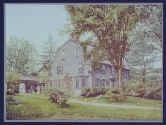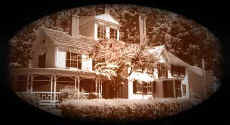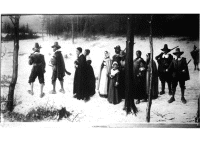| |
The Scarlet Letter
by Nathaniel Hawthorne
 This page contains resources for the study of The Scarlet Letter and the Colonial American life of the 1600s. This page includes links to the following: This page contains resources for the study of The Scarlet Letter and the Colonial American life of the 1600s. This page includes links to the following:
Background Information
Nathaniel Hawthorne’s The Scarlet Letter explores the conflict between private truth and public appearances, and the choice between sin and salvation. Although written in the 19th century, and focusing on the story of 17th century Hester Prynne, branded with a large, red “A” because of her adulterous relationship, explores questions still asked today:
- What is moral?
- And what is good?
The Scarlet Letter was written by Nathaniel Hawthorne and published in 1850. Click on a link below for interesting background material:
- About the Author - Biographical Information about Nathaniel Hawthorne (1804-1864)
- Setting - The Scarlet Letter is set in Boston, MA in June 1642. A number of historical figures, places and events help pinpoint this date.
- Religion - Colonial Massachusetts was a Puritan colony
- Characters - A description of the principal characters in the novel
Assignments
- Pre-reading Assignment
- Scarlet Letter Day Assignment - The Scarlet Letter Assignment forms the core of our studies into life in Colonial times. This is an opportunity to experience first hand some of the trials and tribulations faced by Hester Prynne in the novel.
- Each student shall select a letter to wear publicly for an entire school day (exact date to be announced). The letter must represent a sin, of which the student is guilty.
- Following the wearing of the student's personal scarlet letter, a reflective writing assignment is required. In this writing assignments students must include the following:
- An introductory paragraph describing the assignment
- One paragraph describing the decision the student made in selecting his/her letter
- One paragraph describing the experience of wearing the letter
- thoughts and feelings at the start of the day
- incidents interacting with other students
- thoughts and feelings when the letter was finally removed
- A concluding paragraph assessing the value of the assignment
- what worked or didn't work
- Essay questions:
- What is the attitude of the narrator towards Puritan America in The Scarlet Letter?
- How is The Scarlet Letter a particularly American story?
- How does the particular place setting affect the action of The Scarlet Letter?
- What does The Scarlet Letter say about the division between what is public and what is private?
- How does Hawthorne use color in The Scarlet Letter?
- In The Scarlet Letter, how do physical traits reflect mental or psychological traits?
- Study Questions - Chapter by Chapter study questions
- Study Questions - the study questions in one pdf file
- Projects - Concluding projects
Top of page
Book Resources
Top of page
Nathaniel Hawthorne Resources
 Nathaniel Hawthorne was born on Independence Day, 1804, in Salem, Massachusetts, the son and grandson of sea captains. Hawthorne’s ancestors had been in Salem for a good part of two hundred years. They came to the New World with Governor Winthrop in 1603. His first two famous ancestors in America were William, a stern persecutor of the Quakers, and William’s son John, one of the three judges at the Salem witch trials in 1692. When Hawthorne was four years old, his father died in Dutch Guiana during a long sea voyage. The boy’s poverty-stricken mother moved herself, Nathaniel, and his two sisters, Elizabeth and Maria Louisa, to the home of relatives in Salem. At the age of about nine, he suffered an injury to his foot. Because he was confined at home for several years, he had time to read many books, especially the works of Sir Walter Scott, John Bunyan, and Shakespeare. As the years passed, Nathaniel was a frequent visitor in an uncle’s home at Raymond, Maine (near Lake Sebago), where he enjoyed outdoor life. Finally, his family moved to Raymond when he was about fourteen years old. Nathaniel Hawthorne was born on Independence Day, 1804, in Salem, Massachusetts, the son and grandson of sea captains. Hawthorne’s ancestors had been in Salem for a good part of two hundred years. They came to the New World with Governor Winthrop in 1603. His first two famous ancestors in America were William, a stern persecutor of the Quakers, and William’s son John, one of the three judges at the Salem witch trials in 1692. When Hawthorne was four years old, his father died in Dutch Guiana during a long sea voyage. The boy’s poverty-stricken mother moved herself, Nathaniel, and his two sisters, Elizabeth and Maria Louisa, to the home of relatives in Salem. At the age of about nine, he suffered an injury to his foot. Because he was confined at home for several years, he had time to read many books, especially the works of Sir Walter Scott, John Bunyan, and Shakespeare. As the years passed, Nathaniel was a frequent visitor in an uncle’s home at Raymond, Maine (near Lake Sebago), where he enjoyed outdoor life. Finally, his family moved to Raymond when he was about fourteen years old.
After preparing for college with a tutor in Salem, Nathaniel entered Bowdoin College, in Brunswick, Maine, from which he was graduated with the class of 1825. Returning to Salem, he spent practically all of his time perfecting the art of writing. He finished and had published in 1828 a novel, Fanshawe, a poorly disguised picture of college life as he had seen it at Bowdoin. He decided that his best form of expression in literature was the tale (what we call the short story). He wrote a number of short tales during this period, many of them published in magazines or in “token” books (gift books for special occasions or holidays). The years from 1825 to 1836 have been called by some critics the “twelve solitary years,” for he stayed in Salem much of the time, traveled only slightly, and had few friends.
In 1837, he published his first collection of stories, Twice Told Tales. Although the book received good reviews, he did not earn the money he had hoped to. At this time, he met Sophia Peabody (a sort of American Elizabeth Barrett Browning),  and the couple became engaged in 1838. To earn money, Hawthorne worked as measurer in the Boston Custom House from 1839 to 1840. For six months in 1841, he lived at Brook Farm, a communal project (which he used as the basis of his long work of fiction, The Blithedale Romance). In 1842, he married Sophia Peabody, and the two settled in the “Old Manse” in Concord. The second volume of Twice-Told Tales was published during this year and received a very complimentary review by Edgar Allan Poe. For three and a half years, Hawthorne and his wife lived extremely happily in Concord, where on very little money they read, wrote, talked, and in general enjoyed life. They liked the company of their Concord neighbors, especially Ralph Waldo Emerson and Henry David Thoreau. and the couple became engaged in 1838. To earn money, Hawthorne worked as measurer in the Boston Custom House from 1839 to 1840. For six months in 1841, he lived at Brook Farm, a communal project (which he used as the basis of his long work of fiction, The Blithedale Romance). In 1842, he married Sophia Peabody, and the two settled in the “Old Manse” in Concord. The second volume of Twice-Told Tales was published during this year and received a very complimentary review by Edgar Allan Poe. For three and a half years, Hawthorne and his wife lived extremely happily in Concord, where on very little money they read, wrote, talked, and in general enjoyed life. They liked the company of their Concord neighbors, especially Ralph Waldo Emerson and Henry David Thoreau.  In 1846, three important things happened in Hawthorne’s life: his son Julian was born; he published a collection of tales written in Concord, titled Mosses from an Old Manse; and he accepted a well-paying position as surveyor at the Salem Custom House. In 1849, the Whigs came into office with Zachary Taylor’s election as president. A faithful Democrat, Hawthorne lost his job, according to the principles of the “spoils system” (to the political victor go the “spoils”). Hawthorne gloomily settled down to finish writing The Scarlet Letter, a novel he had casually begun back in 1847. The Scarlet Letter was published in 1850, and is still considered one of the greatest American novels. In the same year, he moved to Lenox, Massachusetts, where he settled down with his family in a “little red house.” There he wrote The House of the Seven Gables, a study in hereditary consequences of evil, set in Salem. This appeared in 1851. While in Lenox, he was friendly with Herman Melville, who dedicated Moby-Dick (1851) to Hawthorne. Later in that year, Hawthorne and his family (now complete with three children) journeyed to eastern Massachusetts, where they settled for a winter in West Newton. Here he wrote the least successful of his four major long works of fiction, The Blithedale Romance, a study of a socialist community, based upon his stay at Brook Farm. In 1846, three important things happened in Hawthorne’s life: his son Julian was born; he published a collection of tales written in Concord, titled Mosses from an Old Manse; and he accepted a well-paying position as surveyor at the Salem Custom House. In 1849, the Whigs came into office with Zachary Taylor’s election as president. A faithful Democrat, Hawthorne lost his job, according to the principles of the “spoils system” (to the political victor go the “spoils”). Hawthorne gloomily settled down to finish writing The Scarlet Letter, a novel he had casually begun back in 1847. The Scarlet Letter was published in 1850, and is still considered one of the greatest American novels. In the same year, he moved to Lenox, Massachusetts, where he settled down with his family in a “little red house.” There he wrote The House of the Seven Gables, a study in hereditary consequences of evil, set in Salem. This appeared in 1851. While in Lenox, he was friendly with Herman Melville, who dedicated Moby-Dick (1851) to Hawthorne. Later in that year, Hawthorne and his family (now complete with three children) journeyed to eastern Massachusetts, where they settled for a winter in West Newton. Here he wrote the least successful of his four major long works of fiction, The Blithedale Romance, a study of a socialist community, based upon his stay at Brook Farm.
 In 1852, he bought a home in Concord named “The Wayside,” where he wrote the presidential campaign biography for his Bowdoin College friend, Franklin Pierce. The Democrats won the election, and a grateful Pierce appointed Hawthorne United States consul in Liverpool, England. From 1853 to 1857, the Hawthornes were in England. He found time to travel throughout parts of the British Isles, recording his impressions in journals, which have been published as the English Notebooks. From 1858 to 1859, the Hawthornes were in Italy, where he gathered much material, some of which was published later as the Italian Notebooks, and some of which became the background of his last complete novel, The Marble Faun. This last book, a long and detailed study of good and evil, and of Americans in Europe, was published in 1860. Returning to America in the same year, he settled with his family in Concord, where his health began to fail. His writing powers decreased, although he was able to incorporate some of the material of the English journals into a book of excellent essays about England, Our Old Home. Toward the end of his life he suffered rapid deterioration, and he died on May 19, 1864, while on a trip to the White Mountains of New Hampshire with his friend Franklin Pierce. In 1852, he bought a home in Concord named “The Wayside,” where he wrote the presidential campaign biography for his Bowdoin College friend, Franklin Pierce. The Democrats won the election, and a grateful Pierce appointed Hawthorne United States consul in Liverpool, England. From 1853 to 1857, the Hawthornes were in England. He found time to travel throughout parts of the British Isles, recording his impressions in journals, which have been published as the English Notebooks. From 1858 to 1859, the Hawthornes were in Italy, where he gathered much material, some of which was published later as the Italian Notebooks, and some of which became the background of his last complete novel, The Marble Faun. This last book, a long and detailed study of good and evil, and of Americans in Europe, was published in 1860. Returning to America in the same year, he settled with his family in Concord, where his health began to fail. His writing powers decreased, although he was able to incorporate some of the material of the English journals into a book of excellent essays about England, Our Old Home. Toward the end of his life he suffered rapid deterioration, and he died on May 19, 1864, while on a trip to the White Mountains of New Hampshire with his friend Franklin Pierce.
(Monarch Notes CD-ROM, 1998, MacMillan Digital Printing, NY, NY)
Top of page
Religion
Nathaniel Hawthorne's Puritan Heritage
 Two of his ancestors were famous Puritans. William Hathorne, who emigrated from England in 1630, was in the Salem militia and was a speaker in the House of Delegates. He was also outspoken against the Quakers. John Hathorne was one of three judges who presided over the Salem Witch Trials of 1692. To make it worse, he was the only one of the judges not to repent in the years following the trials. Nathaniel was so ashamed of his ancestor's actions that he changed his last name by adding a "w". Two of his ancestors were famous Puritans. William Hathorne, who emigrated from England in 1630, was in the Salem militia and was a speaker in the House of Delegates. He was also outspoken against the Quakers. John Hathorne was one of three judges who presided over the Salem Witch Trials of 1692. To make it worse, he was the only one of the judges not to repent in the years following the trials. Nathaniel was so ashamed of his ancestor's actions that he changed his last name by adding a "w".
Hawthorne's Beliefs and His Writings
Some scholars think that he was a later-day Puritan, since he wrote so much about them. Hawthorne believed in the existence of the devil and in determinism (predestination), both Puritan traits. He also thought that people should feel responsible for their ancestor's actions.
As Hawthorne grew, his Puritan beliefs surfaced more and more. They are evident in his analysis of the mind, his somber outlook on living, and his tendency to withdraw from his friends and society.
Hawthorne believed in degrees of sin (that some sins were worse than others), unlike the Puritans. Hawthorne also believed in compassion towards those who have sinned.
Religion in The Scarlet Letter
The Puritans held several beliefs that apply to Hester Prynne's actions.
- Original Sin: seeking self-gratification or placing the self above the community.
- Original Depravity: In people, sin is always preferred over good.
"The Character of an Old English Puritan or Non-Conformist," written in 1646 by the preacher John Geree, describes the curiously contradictory attitude of Puritans toward one another. While a true Puritan "endeavored to have the scandalous cast out of communion," he was also "of tender heart, not only in regard of his own sin, but other's misery."
Hawthorne’s personal belief in degrees of sin is reflected in the character of Reverend Arthur Dimmesdale in The Scarlet Letter, who says that Chillingworth has committed a worse sin than he. Compassion for sinners, another of Hawthorne’s beliefs, is evidenced in the fates of Hester and Dimmesdale.
Top of page
Characters
There are a limited number of characters in The Scarlet Letter. The principal ones are:
Hester Prynne: the main character of The Scarlet Letter. Hester is the mother of Pearl, and is the woman who must wear the scarlet letter. She is the wife of Roger Chillingworth, but Arthur Dimmesdale is Pearl's father. Hester suffers the public humiliation of having to wear the letter "A" on her chest. She lives in Boston until her death.
Pearl: Hester's daughter. Pearl is characterized as a living version of the scarlet letter. She constantly causes her mother and Dimmesdale torment and anguish throughout the novel. Pearl is described as extremely beautiful, but lacking certain Christian qualities. After Arthur Dimmesdale dies, Pearl becomes a normal child and eventually marries.
Roger Chillingworth: Hester's husband from the Netherlands. Chillingworth arrives in Boston the day that Hester is publicly shamed and forced to wear the scarlet letter. He vows revenge on the father of Pearl, and soon thereafter moves in with Arthur Dimmesdale. His revenge is stifled at the end when Dimmesdale reveals that he is Pearl's father before dying. Chillingworth, having lost the object of his hatred, dies soon thereafter.
Arthur Dimmesdale: an eminent minister in Boston and also the father of Pearl. He is a tortured man who constantly places his hand over his hearth when agitated. His health is quite bad, and it is thanks to Roger Chillingworth's potions that he is able to stay alive. Dimmesdale admits to being Pearl's father at the very end of the novel, and reveals that he has a scarlet letter branded into his flesh (this is a symbolic moment, there is no proof that he actually has a scarlet letter branded onto his flesh). He dies upon the scaffold while holding Hester's hand.
Governor Bellingham: the former governor and the man who wants to take Pearl away from Hester. He decides to allow Pearl to stay with her mother after Hester forces Dimmesdale to plead on her behalf.
Mistress Hibbins: the sister of Governor Bellingham. She is said to have been a witch, and rumors told of her stealing into the woods during the night.
Black Man: a name for the devil. The legend speaks of a Black Man who inhabits the woods and gets people to write their names in his book, using their own blood as ink.
John Wilson: the eldest clergyman in Boston, he is a friend of Arthur Dimmesdale.
|
|
|